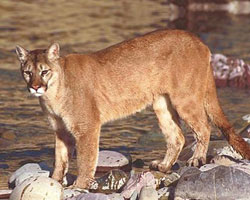Of Rats and Poison

California Urged to Ban Super Toxic Rat Poison that Kills Unsuspecting Wildlife
She was one of 26 mountain lions being studied by National Park Service biologists. Collared back in August along with her brother, Puma-25 had been dead for about a week before hikers found her on an October Sunday in Point Mugu State Park, located in the Santa Monica Mountains.
Her death, though, didn’t come at the barrel of a gun or a swipe from a competing lion. Most likely, the one-year old puma—a “Specially Protected Mammal” in California—died of rat poisoning, either by consuming it herself or eating an animal that itself ate the poison. And Puma-25 is not alone.
According to the California Department of Fish and Game, so far there have been 240 confirmed cases of non-targeted wildlife being exposed to rodenticides. These highly toxic anticoagulants work by interfering with blood clotting, resulting in uncontrollable bleeding that leads to death.
Second-generation anticoagulants, created because rats and mice built up resistance to the first generation,take longer to break down and therefore move more easily up the food chain. Basically, a rat eats the poison; an animal eats the poisoned rat; the animal dies. According to state and federal officials, wildlife likeraptors, eagles, bobcats and kit foxes have been poisoned or killed by rodenticides. Even in remote areas of Northern California, research has revealed unacceptably high levels of poison in an endangered forest predator, the Pacific fisher, where 75% of fishers tested showed rodenticide contamination.Despite the large body count, these super-toxic rat poisons are available for sale to urban and suburban homeowners.
Recently, a coalition of environmental and public health groups called on the California Department of Pesticide Regulation to ban the poison due to its detrimental effects on wildlife. Their request echoes concerns of state wildlife officials and the U.S. Environmental Protection Agency, which have both stressed the need to restrict these dangerous products, which cause thousands of poisoning cases of children each year.
Despite the threat these poisons present, the California Department of Pesticide Regulation has ignored repeated requests to regulate them for more than a decade. Meanwhile, these rodenticides continue to kill off the very predators that perform natural rodent control by eating rats and mice. Luckily, the solution to this problem is relatively simple, says attorney Greg Loarie of Earthjustice, one of the groups to request the ban. “We have a genuine crisis on our hands,” he says. “We need to take these products off the market and use safer alternatives.”

